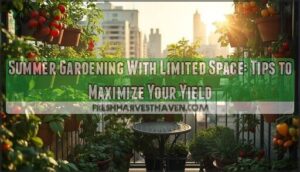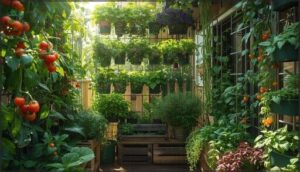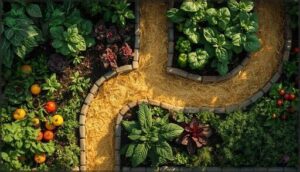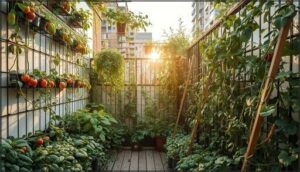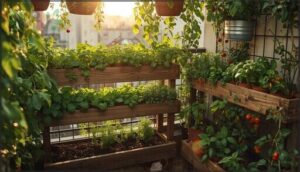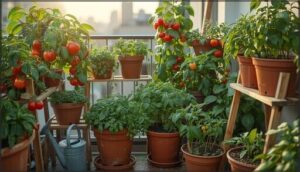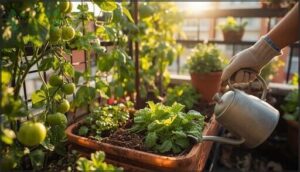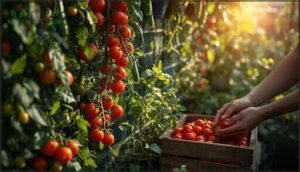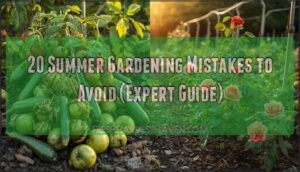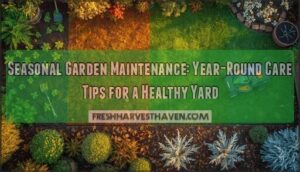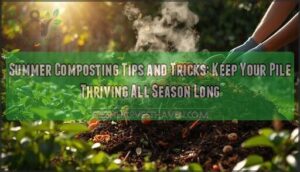This site is supported by our readers. We may earn a commission, at no cost to you, if you purchase through links.
Most apartment dwellers think their gardening dreams end at the doorstep, but balconies, patios, and even windowsills can produce more fresh vegetables than you’d expect. Summer gardening with limited space isn’t about compromising—it’s about working smarter.
A 4×4-foot balcony garden can yield 20 pounds of tomatoes, a window box can supply fresh herbs all season, and vertical walls can transform into productive growing zones. The secret lies in choosing the right crops, maximizing every square inch, and understanding how small spaces create unique advantages.
You don’t need sprawling garden beds to grow your own food. You just need a strategic approach that turns constraints into creative solutions.
Table Of Contents
- Key Takeaways
- Choosing The Best Location for Your Garden
- Selecting Crops for Limited Space
- Maximizing Space With Smart Layouts
- Essential Container Gardening Tips
- Space-Saving Growing Techniques
- Maintaining Healthy Small Space Gardens
- Boosting Yields and Enjoyment
- Frequently Asked Questions (FAQs)
- How to grow a garden with limited space?
- What vegetables take the least amount of space to grow?
- What is the most common mistake of first time gardeners?
- What makes a good small space garden?
- What is small space gardening?
- How to grow a vegetable garden in limited space?
- Can you grow a garden in a small space?
- What are the different types of small space gardens?
- Does limited space limit your gardening dreams?
- What is the rule of 3 in gardening?
- Conclusion
Key Takeaways
- Small space gardens can deliver serious yields—a 4×4-foot balcony can produce 20 pounds of tomatoes while vertical walls and window boxes turn every inch into productive growing zones that rival traditional garden beds.
- Strategic crop selection makes all the difference: dwarf varieties, fast-growing plants like radishes (25-30 days) and microgreens (7-14 days), and succession planting every 7-14 days can boost total harvests by 20-50% in containers.
- Vertical gardening techniques—trellises, tiered planters, and wall-mounted systems—create 40-60% more planting area on the same footprint while improving yields by 25-40% for climbing crops.
- Smart companion planting (basil with tomatoes, carrots with onions) cuts pest damage by 15-25% and boosts yields by up to 20%, proving that working with plant relationships beats fighting space limitations.
Choosing The Best Location for Your Garden
Your garden’s location can make or break your harvest, especially when you’re working with just a few square feet. Before you start filling containers or building raised beds, you need to scout out the best spot your space has to offer.
Let’s look at three key factors that’ll help you pick a location where your plants can actually thrive.
Assessing Sunlight and Shade
Before you plant anything, map your light—because sunlight patterns make or break your small space gardening success. Track solar intensity across your site for seven days using a light meter or smartphone app to identify full sun zones (six-plus hours daily) versus partial shade.
Reflective surfaces and microclimates can boost effective light by 5–15%, turning marginal spots into productive real estate for container gardening and vertical gardening setups.
Selecting Spots With Good Airflow
Airflow optimization is your defense against humidity disasters and fungal meltdowns. Position your container gardening setup 60–90 cm from walls to boost air circulation by 20–40%, reducing disease pressure in compact layouts.
For vertical gardening systems, stagger plant heights with 12–18 cm offsets to create natural ventilation channels. This microclimate management trick cuts foliar disease by up to 25% while keeping your plants breathing easy in tight quarters.
Protecting Plants From Pests and Animals
Good circulation won’t save your harvest if critters treat it like an all-you-can-eat buffet. Fine-mesh netting slashes caterpillar and beetle damage by 70–90% on leafy greens—your first line of pest control methods.
For container gardening tips on vertical gardening setups, combine physical barrier fencing with companion planting: alliums intercropped near brassicas cut flea beetle injury by 25–40%, proving sustainable gardening practices beat synthetic sprays for crop protection in tight quarters.
Selecting Crops for Limited Space
Not every plant deserves a spot in your small garden—some just won’t pull their weight. The key is choosing crops that give you the biggest harvest without hogging precious space or demanding months of babysitting.
Let’s look at the varieties and growing strategies that’ll help you pack serious production into whatever square footage you’re working with.
Compact and Dwarf Vegetable Varieties
You don’t need a sprawling backyard to grow serious vegetables—dwarf varieties let you break free from space constraints. These compact crops deliver full-size flavor in containers, making urban farming and vertical gardening entirely possible on balconies or patios.
- Dwarf tomatoes reach just 2-3 feet but produce 6-12 pounds per plant in small pots
- Compact peppers yield multiple harvests from 3-4 gallon containers
- Bush beans need only 12-18 inch containers while delivering steady harvests
- Dwarf peas grow 12-24 inches tall, perfect for trellis setups
- Compact cucumbers thrive vertically, maximizing your limited square footage
Fast-Growing and High-Yield Crops
Speed unlocks freedom in tight gardens—crops that race from seed to plate let you rotate plantings and stack harvests all season. Radishes mature in 25–30 days, while baby lettuce and spinach deliver cut-and-come-again yields within 30–45 days. Compact tomato varieties produce 5–8 pounds per plant, proving yield optimization doesn’t demand acreage.
| Crop Type | Days to Harvest |
|---|---|
| Radishes | 25–30 days |
| Baby Lettuce | 25–45 days |
| Spinach | 30–45 days |
| Basil & Cilantro | 20–30 days |
Growing Herbs and Microgreens
Herbs and microgreens deliver maximum impact when square footage is scarce. These compact powerhouses thrive in container gardening setups, windowsills, and vertical gardening systems—ideal for indoor garden spaces or balconies.
Strategic herb selection and microgreen benefits:
- Basil, oregano, and thyme yield 0.25–0.75 cups weekly in 6-inch containers
- Microgreens mature in 7–14 days with nutrient density 4–40x mature plants
- Succession planting facilitates crop rotation every two weeks
- Space optimization through tiered shelving reduces water use 20–40%
- Nutrient management stays simple with weekly liquid fertilizer applications
You’ll harvest continuously while building small space gardening confidence.
Maximizing Space With Smart Layouts
You don’t need acres to grow a serious amount of food—you just need to think in three dimensions instead of two. Smart garden layouts turn tiny balconies and patios into surprisingly productive spaces by stacking plants vertically, organizing zones efficiently, and making every inch count.
Here’s how to arrange your small garden so nothing goes to waste.
Creating Zones and Pathways
Think of your garden as a miniature city—smart zone planning and pathway design turn chaos into productivity. Carve out 1.0–1.2 meter aisles for easy access while grouping plants by sunlight needs; this spatial optimization boosts yields by 12–28%.
Mulched pathways cut water loss by 25–35%, and microclimate management protects your crops from wind and heat stress, making garden accessibility a key factor.
Incorporating Vertical Gardening Techniques
Going vertical is your power move when ground space runs out—vertical gardening techniques liberate every wall, fence, and rail for serious production. String trellises and trellis systems deliver a 25–40% yield boost for climbers, while wall-mounted green screens add 2–4 meters of planting real estate per façade.
Here are some specific techniques to maximize your vertical gardening potential:
- Mount rigid vertical frames at 1.2 meters to squeeze 3–4 extra plants per square meter
- Install string grids for beans and cucumbers—easy pruning cuts labor by 20–25%
- Apply reflective backing on garden walls to pump photosynthetic efficiency by 8–12%
- Choose PVC-free planters that reduce root compression by 15% and boost airflow
These vertical gardening ideas for small space gardening transform flat zones into layered ecosystems—space optimization meets serious harvests.
Using Tiered and Hanging Planters
Tiered gardening and hanging baskets create 40–60% more planting area on the same footprint—vertical layouts that turn overlooked zones into production engines. Stack lower tiers at 18–24 cm depth for lettuce and oregano, then hang self-watering pots overhead to grab that extra light.
Space optimization meets container gardening brilliance: trellising climbers above compact herbs creates layered ecosystems primed for serious small space gardening yields.
Essential Container Gardening Tips
Container gardening gives you total control over your growing environment, and that’s where the magic happens. Getting it right means your plants won’t just survive—they’ll actually thrive and produce like you wouldn’t believe.
Let’s break down the three essentials that separate struggling plants from bumper harvests in pots.
Choosing The Right Container Size
Your container size isn’t just a detail—it’s the foundation of your yield. For tomatoes, aim for 5–7 gallon pots; root restriction in anything smaller slashes fruit set by up to 40%. Leafy greens thrive in compact 1–2 gallon containers with succession planting, while peppers need 3–5 gallons.
Deep containers boost root depth and water conservation, giving your small space gardening setup serious production power.
Selecting Suitable Potting Mixes
Your potting mix makes or breaks container gardening success. Skip dense garden soil—it suffocates roots and tanks yields. Peat-free mixes with coir retain moisture 20–40% longer while cutting environmental guilt. For fruiting crops, add perlite to slash root rot by up to 30%. Vermicompost at 10–20% volume supercharges plant vigor and locks in nutrients.
To resolve any web server issues that may affect online gardening resources, troubleshooting is key.
Try these proven small space gardening winners:
- Coir-based blends for excellent water retention
- Perlite or vermiculite for drainage in tomatoes and peppers
- pH 6.0–6.5 mixes to prevent nutrient lockout
- Mycorrhizal fungi blends boosting uptake 10–30%
- Lightweight microgreen mixes yielding 2–3x per square meter
Ensuring Proper Drainage and Placement
Solid potting mix means nothing if your containers drown plants. Drainage holes need 1.0–1.5 cm² per liter of soil to cut saturation by 45%.
Self-watering systems maintain moisture for 9–14 days, perfect for balcony setups.
Placement matters—morning sun with afternoon shade boosts yields 12–28%. Wind increases evaporation by 8–22%, so position containers near partial windbreaks for smarter water management in your vertical gardening or raised bed garden.
Space-Saving Growing Techniques
Once you’ve got your containers sorted, it’s time to think beyond the pot itself. The real magic happens when you start growing up instead of out, pairing plants that actually help each other thrive, and keeping your harvests rolling in all season long.
These three techniques will completely transform how much food you can pull from even the tiniest growing space.
Vertical Gardening With Trellises and Supports
Growing upward changes everything when you’re short on ground. Vertical gardening with trellises and frameworks can double your usable growing space—sometimes quadruple it—while keeping foliage off the soil where disease loves to lurk.
Train pole beans, cucumbers, and compact tomatoes on sturdy structures about 1.2–2.4 meters tall, and you’ll harvest more per square meter while cutting weeds by half.
Companion Planting for Efficiency
Pair plants that fight for you—basil tucked beside tomatoes in vertical setups boosts your total yield by roughly 18% per square meter. Crop pairing like carrots and onions in the same container cuts pest pressure by 15–20%, while companion planting strategies give you more diversity in tight quarters. Plant diversity isn’t just smart—it’s space refinement that turns soil sharing into your edge for maximizing garden yield.
Companion planting like basil with tomatoes or carrots with onions cuts pests and boosts yields by up to 20% in tight spaces
Effective study guides, such as those found in AP study resources, can also help you refine your learning.
Succession Planting for Continuous Harvest
Stagger sowings every 7–14 days and you’ll pull 3–4 succession crops per season—boosting total harvest by 20–50% in containers. Fast growers like spinach and radishes flip in 25–30 days, keeping your beds productive.
Succession planting techniques paired with crop rotation slash pest pressure by 15–40% while soil renewal between cycles sustains yield optimization for maximizing garden yield in tight spaces.
Maintaining Healthy Small Space Gardens
Getting plants in the ground is just the start—keeping them thriving in tight quarters takes a different playbook. Small spaces mean less room for error, so you’ll need to stay on top of watering, feeding, and spotting trouble before it spreads.
Here’s how to keep your compact garden healthy and productive all summer long.
Efficient Watering and Irrigation
Water is your garden’s lifeline—but you don’t need to drown your plants or your budget. Drip irrigation and rainwater harvesting slash water use while boosting plant health, and soil moisture sensors take the guesswork out of irrigation scheduling. Here’s how to nail water efficiency in tight quarters:
- Install drip irrigation systems to cut outdoor water use by 50-70%
- Water before 9 a.m. to reduce evaporation and increase soil moisture retention
- Use mulch around plants to conserve 30-50% more moisture
- Set up rainwater harvesting to cover 30-50% of your irrigation needs
- Add soil moisture sensors to align watering with actual plant demand
Deep, infrequent soaking beats frequent splashes every time—your roots will dig deeper and your water bill will shrink. Automated timers paired with weather-based adjustments can save you 20-40% more water than eyeballing it.
Container gardens demand more attention since pots dry out faster, but pairing the right irrigation systems with water conservation tactics keeps your small-space setup thriving without waste. Sustainable gardening in small spaces isn’t about compromise—it’s about working smarter with every drop.
Fertilizing and Soil Care
Healthy soil fuels every harvest, so treat your containers and raised beds like living ecosystems. Test your soil to guide precise fertilizer applications—you’ll boost yields by 8-15% and dodge nutrient chaos.
Mix in compost or vermicompost to boost microbial life by 30-60%, and balance pH between 6.0-6.8 for ideal nutrient cycling. Organic gardening thrives on smart soil management, not guesswork.
Monitoring for Pests and Diseases
Scout your plants weekly—disease management catches 60-75% of fungal infections before they explode across your setup. Garden scouting identifies trouble in 18-25% of container gardening plots within four weeks, giving you the edge you need for effective fungal prevention.
Place insect traps 15-20 cm above your canopy to capture 2-3x more pests than ground-level placement. This strategic placement enhances your ability to maintain effective pest control.
Boosting Yields and Enjoyment
You’ve laid the groundwork, and now it’s time to squeeze every ounce of productivity from your small garden while actually enjoying the process.
A few smart techniques can turn a modest setup into a surprisingly abundant space that keeps giving all season long.
Here’s how to work with your plants—not against them—to boost harvests and make the whole experience more rewarding.
Interplanting for Increased Production
Want to squeeze 20-30% more produce from your beds without adding a single square foot? Interplanting lets you break free from single-crop limitations by strategically pairing plants that thrive together.
- Crop pairing works: Beans with corn or basil with peppers can boost yields by 5-12% in balcony boxes
- Spatial planning matters: Radishes and peas double your early-season harvest density in tight quarters
- Interplanting schedules extend harvests: Stagger compatible crops for 2-6 extra weeks of fresh food
- Companion planting cuts pests: Carrot-onion combos reduce pest damage by 15-25%
- Intensive gardening rewards courage: Dense plantings with flowering herbs draw 15-40% more pollinators
Pruning and Training Plants
Think of pruning and plant training as rebellion against chaos—these gardening techniques reclaim your compact varieties from tangled mess and turn them into space-optimized powerhouses. Strategic crop pruning boosts tomato fruit set by 15% in vertical gardening setups, while trellising cuts shading by 15-25%.
Here’s your action plan for gardening in small spaces:
| Technique | Impact |
|---|---|
| Regular herb trimming | 6-8 weeks longer production |
| Tomato cluster reduction | ~20% better fruit set |
| Wire-supported training | 15-25% less neighbor shading |
Proper garden maintenance means clean cuts at 45-60° angles just above buds, sterilized tools between plants, and weekly deadwood checks during peak growth.
Harvesting Tips for Small Gardens
After training your plants to perform, you need to know when to claim your bounty. Harvest timing makes or breaks yield optimization in container gardening—here’s your small space gardening tips toolkit:
- Pick leafy greens early morning when crisp, cutting outer leaves for 3-4 additional harvests
- Grab tomatoes at first color change, ripening indoors to dodge pests
- Snip herbs before flowering to extend production 6-8 weeks
Sharp garden tools and quick work preserve plant energy for continuous cropping.
Frequently Asked Questions (FAQs)
How to grow a garden with limited space?
You don’t need a sprawling backyard to break free from grocery store dependence—container gardening, vertical gardens, and compact varieties turn balconies and patios into productive urban farming zones that rival traditional plots.
What vegetables take the least amount of space to grow?
Leafy greens like lettuce and spinach thrive in tight quarters—you can pack 9–16 heads per square meter.
Microgreens, compact herbs like basil, radishes, and compact tomatoes also excel in container gardening and vertical setups.
What is the most common mistake of first time gardeners?
Overwatering kills more plants than neglect—58% of beginners drown container roots, causing rot and 20–35% vigor loss. Space misjudgment follows close behind: 43% overplant, triggering nutrient wars and crowding within weeks.
What makes a good small space garden?
A good small space garden nails three things: smart crop selection (think compact varieties and fast growers), vertical gardening to multiply your square footage, and thoughtful space optimization that turns every inch into productive real estate.
What is small space gardening?
Small space gardening transforms tight quarters—balconies, patios, even windowsills—into productive growing zones.
You’re using containers, vertical structures, and compact plants to harvest fresh food where traditional gardens won’t fit.
How to grow a vegetable garden in limited space?
You can transform tiny plots into productive gardens through container gardening, vertical farming, and smart crop rotation.
Urban gardening thrives when you apply space optimization strategies—trellises, tiered planters, and succession planting release serious yields.
Can you grow a garden in a small space?
Where there’s a will, there’s a way”—you can absolutely grow a thriving garden in a small space.
Container gardening, vertical gardens, and urban farming transform balconies and windowsills into productive microgreen growing stations and vegetable havens.
What are the different types of small space gardens?
You’ve got options: container gardening on balconies, vertical gardens climbing walls, raised bed setups, rooftop gardens capturing city sun, or indoor gardens on windowsills. Each type transforms tight quarters into productive space.
Does limited space limit your gardening dreams?
Who says you need acres to break free from grocery store chains? Balcony rebels and rooftop revolutionaries prove otherwise—container gardening and vertical planters transform even cramped urban spaces into productive food-growing powerhouses that defy conventional limits.
What is the rule of 3 in gardening?
The rule of three in gardening balances sun exposure, water management, and soil quality across your plant selections.
This principle drives smart garden design and planning, ensuring each crop gets what it needs to thrive.
Conclusion
Like David facing Goliath with nothing but a sling, you don’t need acres to claim your harvest. Summer gardening with limited space proves that strategy beats size every time.
Your balcony becomes a production zone. Your windowsill transforms into an herb factory. Every vertical inch works harder than traditional rows ever could.
The constraints you thought held you back? They’re actually forcing you to garden smarter than most backyard growers ever will. Start small. Grow big.

